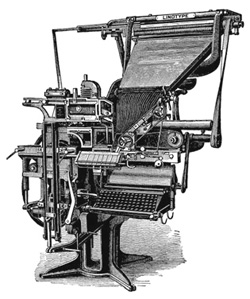Books and Articles
- History of the Linotype Company by Frank Romano
- The Biography of Ottmar Mergenthaler by Carl Schlesinger
- Ottmar Mergenthaler, The Man and His Machine by Basil Kahan
- Machine Writing and Typesetting by Frank Romano
- Miracle Man of Printing by I. E. Levine
- The Manual of Linotype Typography, 1923 Digitized version
- A History of Typesetting From the Printing Press to the Digital Era
Also visit http://en.wikipedia.org/wiki/Linotype_machine
Other Films about the Linotype
- PrintingFilms.com - Preserving the visual history of the printed word
- Typesetting 1960 - Explains the intricate detail of the Linotype
- Printing 1947 - Printing as “Your Life Work” in 1947
- Guardian Newspaper Printing - Printing an edition of the Guardian in 1960
- Eldon Meeks Runs a Linotype - The fastest Linotype operator alive?
- Present! - Jim Gard demonstrates the use of a Model 5 Linotype
- The Legend of the Linotype - Print museum demonstration
- True to Type: Running America’s Last Linotype Newspaper - “The Saguache Crescent” newspaper
Printing Museums with Linotypes
- Museum of Printing - Haverhill, MA
- Baltimore Museum of Industry - Baltimore, MD
- International Printing Museum - Carson, CA
- Museum of Printing History - Houston, TX
- C.C. Stern Type Foundry - Portland, OR
- Vermilion News Print Shop Museum - Vermilion, OH
- Linotype Museum - Shopfheim, Germany (now closed)
- German Engineering Museum - Berlin, Germany
- Hessian State Museum - Darmstadt, Germany
- Museum of Printing Arts - Leipzig, Germany
- Museum of Work - Hamburg, Germany
- Musee de l'imprimerie - Lyon, France
- Association pour le Patrimoine Industriel (API) - Geneva, Switzerland
- Typo Rama - Bischofszell, Switzerland
- John Jarrold Printing Museum - Norwich, UK
- National Print Museum - Dublin, Ireland
- Grafisch Museum, Groningen - Groningen, Netherlands
- Museum of Industrial Archaeology and Textiles - Ghent, Belgium
- Vingaards Officin - Viborg, Denmark
- Typography Museum - Crete, Greece
- imPRESSed Studio - Johannesburg, South Africa
- Melbourne Museum of Printing - Melbourne, Australia
- The Printing Museum - Wellington/Paraparaumu, New Zealand
North America
Europe
Africa
Australia & NZ
Linotype Resources
- Hot Metal Services - Traveling Linotype repairman, Dave Seat
- Linotype University - Learn about the Linotype in Denmark, IA (now defunct)
- Linotypesetting.com - Online source for hot metal composition
- Don Black Linecasting - Hot metal and letterpress equipment
- Linecasting Machinery Ltd UK - Special hot metal engineers in the UK
- Metal Type UK - All things metal type
About the Linotype

The Linotype sped up printing production by mechanizing the process of setting type that is printed for newspapers and books. Before Mergenthaler's invention, typesetting was a time-consuming process that was done by hand and was the major bottleneck in the production of printing.
The Linotype casts an entire line of type at one time (hence the name “Line o’ Type”). It produces printable type six times faster than a person. With the invention of the Linotype, the printing of newspapers and books skyrocketed. This dramatically changed journalism and society as a whole.
Ottmar Mergenthaler emigrated from Germany to Baltimore, Maryland in 1872. While employed by his cousin, he began working on the complex challenge of mechanical typesetting. Although many people were competing to invent a machine that could set type mechanically, it was Mergenthaler's mechanical genius that eventually found the solution. His first working machine was put into service at the New York Tribune in 1886.
The Linotype was the machine everyone was waiting for. Even a syndicate of investors that tried to control the Linotype could not stop the almost instantaneous popularity of the machine. Sadly, Mergenthaler never saw the full impact of his invention as he died of tuberculosis in 1899 at the age of 45.
The Linotype quickly became an indispensable part of the printing industry. By the early 20th century, there were tens of thousands of machines in service all over the world in many different languages. The explosion of printing created jobs for highly-skilled workers that became specialists in the Linotype.
Photo typesetting technology began to overtake the Linotype in the early 1950s. By the 1970s, the Linotype was no longer state-of-the-art, and printers started scrapping the machines because they were thought to be obsolete. Today, very few machines exist. Even fewer are in operation.